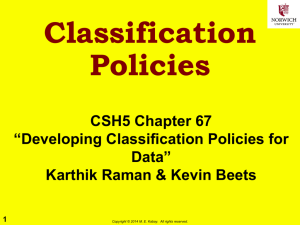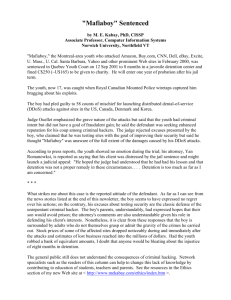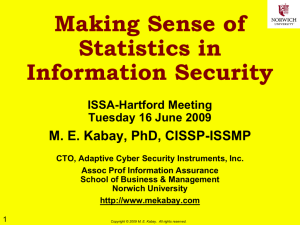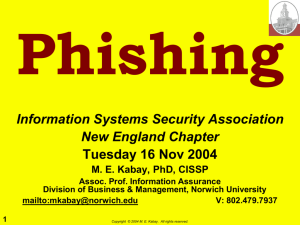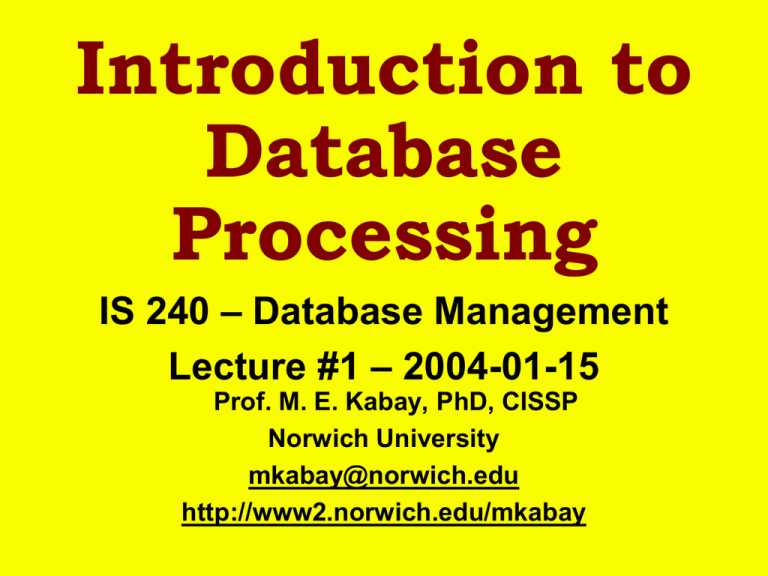
Introduction to
Database
Processing
IS 240 – Database Management
Lecture #1 – 2004-01-15
Prof. M. E. Kabay, PhD, CISSP
Norwich University
mkabay@norwich.edu
http://www2.norwich.edu/mkabay
Topics
Why study DBMS?
DBMS Applications
Historical Overview
Defining “Database”
How a DBMS Is Used
Historical Development of DBMS
Some Fundamental Issues in DB Applications
HOMEWORK
2
Copyright © 2004 M. E. Kabay. All rights reserved.
Why study DBMS?
Central technology of today’s information
technology (IT)
Teaches orderly analysis of data
requirements and relationships
Opportunity to understand internals
underlying externals of applications
Provides basis for rapid assimilation and
application of wide range of specific DBMS
tools
Structured Query Language (SQL) almost
universally used in industry
Increases likelihood of good jobs
3
Copyright © 2004 M. E. Kabay. All rights reserved.
DBMS Applications
DBMS = database management system
Database contains one or more tables (files,
datasets)
columns = fields
rows = records
Relations among tables help navigate DB
DB Application allows access to database
usable formats
data entry
reports
4
Copyright © 2004 M. E. Kabay. All rights reserved.
Concurrency
Single-user database allows only one user at
a time
aka exclusive access
Types of access permissions
READ
WRITE
APPEND
LOCK
Multi-user databases need to protect against
damage to records
5
Copyright © 2004 M. E. Kabay. All rights reserved.
TIME
Concurrency (cont’d)
Joe accesses Widget record
Shakheena accesses Widget record
Inventory shows 25 to both
Joe takes out 10
Application writes out record to DB
Inventory now shows 15
Shakheena takes out 5 from her copy of data (25)
Inventory now shows 20
6
Copyright © 2004 M. E. Kabay. All rights reserved.
Historical Overview
How did people handle masses of data?
Manual systems
Clay tablets
Parchment
Paper
Abacus
Punch cards (1890-1960)
File systems (1950-present)
DBMS (1970-present)
7
Copyright © 2004 M. E. Kabay. All rights reserved.
Problems with File Systems
Separated, isolated data
Duplication of data
File-format dependency
File incompatibilities
Hard to show useful views of data
8
Copyright © 2004 M. E. Kabay. All rights reserved.
Problems: Separated,
Isolated Data
Multiple files for different aspects of system
Linkages handled entirely by application
programming
Coordinate access to multiple files for
different functions
Some databases have hundreds of files
9
Copyright © 2004 M. E. Kabay. All rights reserved.
Problems: Duplication Of
Data
Early collections of files duplicated data
e.g., identifiers (name, address. . . .)
Easy to generate discrepancies
copies of data in different records and
different files could diverge from each
other
Frustrating for users and clients
enter same information over and over
Results inconsistent, contradictory
send invoice to old address in one
program, new address in other program
10
Copyright © 2004 M. E. Kabay. All rights reserved.
Problems: File-format
Dependency
Structure of data files hard-coded in
application program
All changes to data files requires modification
of programs
rewrite data description
rewrite special code for linking or
searching
recompile source code to generate object
update documentation
11
Copyright © 2004 M. E. Kabay. All rights reserved.
Problems: File
Incompatibilities
Different analysts and programmers used
different data definitions
NAME has 20 chars
NAME has 40 chars
Different names for fields
SSN vs SS#
LAST_NAME vs L_NAME
Different record structures
LAST | FIRST | STREET1 | STREET 2 | CITY
NAME | ADDRESS | CITY_&_STATE
12
Copyright © 2004 M. E. Kabay. All rights reserved.
Problems: Hard To Show
Useful Views Of Data
Combining fields from different records in
different files necessary for most users
reports
on-screen visualization
Every report / screen requires special
programming
find data (often by serial search)
place in output in specific positions
all require a great deal of programming
13
Copyright © 2004 M. E. Kabay. All rights reserved.
Defining “Database”
“A database is a self-describing collection of
integrated records.”
Self-describing
Integrated
Model of a model
14
Copyright © 2004 M. E. Kabay. All rights reserved.
How a DBMS Is Used
APPLICATION
PROGRAMS
TOOLS
API
INTERNALS
DATA DICTIONARY
DATA
15
Copyright © 2004 M. E. Kabay. All rights reserved.
QUERY
Self-describing
Databases have data dictionaries
aka data directory or metadata
Data dictionary supports independence between
programs and database
Change in data dictionary does NOT usually
require change in program
Enormous reduction in programming
complexity and maintenance of programs
Data dictionary supports independence between
database and documentation
Constant problem: bad documentation
DBMS helps reduce dependence on manual
documents
16
Copyright © 2004 M. E. Kabay. All rights reserved.
Integrated
Files are accessed in systematic way
Special files maintain indexes that help speed
access
“Find all records where name begins with
S”
Find records where city_population >
750,000 and household_median_income >
$50,000
Application metadata can include report
structures
“Print the invoice for Mrs Smith’s fuel oil
deliveries this month”
17
Copyright © 2004 M. E. Kabay. All rights reserved.
Model of a model
Databases are designed by people
DB does not directly reflect “reality”
DB reflects designer’s decisions about
how to represent user’s perceptions of
what matters
“The availability of a tool determines
perceptions of what’s a reasonable request.”
As users learn to use their DB, they begin
to think in new ways
Recognize new possibilities, need new
functions
Databases evolve as they are used
18
Copyright © 2004 M. E. Kabay. All rights reserved.
Historical Development of
DBMS
1970s: E. F. Codd – relational DB model
normalization of data
reduce repetition
1980s: Microcomputers: dBase II
not DBMS
not relational
but interfaces improved
mainframe products ported to PCs
19
Copyright © 2004 M. E. Kabay. All rights reserved.
Historical Development of
DBMS (cont’d)
Mid-1980s: client-server architecture
Link inexpensive computers in networks
(LANs)
Store data on servers
Run client programs on workstations for
user interface, some computations, reports
1990s: Web-based systems
Web exploded into use ~1993
Common interface: browser
client software reading standard
formatting codes – HTML, XML, JAVA
20
Copyright © 2004 M. E. Kabay. All rights reserved.
Some Fundamental Issues in
DB Applications
Ethical constraints on data gathering and
usage (details later in course)
How do we protect data subjects against
abuse?
Security (details later)
confidentiality
control
integrity
authenticity
availability
utility
21
Copyright © 2004 M. E. Kabay. All rights reserved.
Homework
Study Kroenke Chapter 1 using SQ3R
By next Thu, 23 Jan 2003: required
Write out answers to each of the Group 1; print
your responses and bring them to class
Questions 1.1 through 1.23 using a computer
(23 points)
Short (½ to 1 page) response to Project A on
page 23 (2 points)
Short response to Project B (2 points)
22
Copyright © 2004 M. E. Kabay. All rights reserved.
For Extra Credit
1 point each: optional
Write out & print answers by Thu 30 Jan 2003
FiredUp Project Question A
FiredUp Project Question B (only if A done)
23
Copyright © 2004 M. E. Kabay. All rights reserved.
Preparation for Next Class
Review Kroenke Chapter 1
Scan Kroenke Chapter 2
Apply SQ3R global scan to Ferrett et al
Study Ferrett et al Projects 1 & 2
Load files from Ferrett CD-ROM onto your
own computer if you have one
Amazon has the 1st chapter of Kroenke;
search on Kroenke and look for the 8th
edition.
Also see the Kroenke Web site at
http://www.prenhall.com/kroenke
24
Copyright © 2004 M. E. Kabay. All rights reserved.
DISCUSSION
25
Copyright © 2004 M. E. Kabay. All rights reserved.


